|
|
| Judy Anderson & Ginny Hoyle ~ Colorado Share this page: |
| |
|
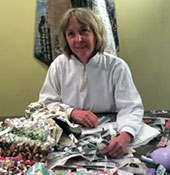 |
Judy Anderson is an artist, teacher, and arts administrator with over 30 years of experience in the field. She is the artistic/founding director of PlatteForum, a non-profit art center in Denver,
Ginny Hoyle’s poetry has appeared in MARGIE, Copper Nickel, Wazee Journal, Pilgrimage, Tygerburning and other journals. She works with artist Judy Anderson to create freeform books and installations that meld language and art. |
| |
|
|
When We Were Birds Project Bookworks
X Press Publications |
|
| |
|
Caroline's Garden: An Ode
By Judy Anderson
Denver, Colorado: Judy Anderson, 2016. One-of-a-Kind.
Scroll: 75" x 10" extended. Embroidered and painted linen fabric with machine stitching and wood end-pieces. Front side of scroll painted with acrylic paints. Reverse left raw showing exposed underside of the embroidery on linen. Laid in fabric-covered clamshell box (7.5" x 10.5" x 2.75") with embroidered illustration and title on lid. Ribbon closure. Signed and dated by the artist.
Judy Anderson: "This book began ten years ago during my monthly visits with my mother in her California assisted living home. Traveling with linen fabric and embroidery floss was easy to pack and filled the days with my mom. The book expresses the amazing attributes of this incredible woman, her humor, love of gardening, dancing, and grace. When she died I transformed the embroidered linen by painting the front, cutting the piece in half and stitching it together to create a long scroll. The back was left raw with only the embroidery and linen exposed. Rolled in a scroll, it is placed in a clamshell box with embroidered cover. I think of the hymn: In The Garden: 'I come to the garden alone, while the dew is still on the roses.' Her spirit is there and with me always."
$1,750 |
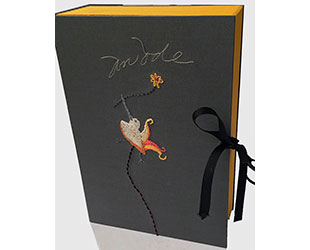 Click image for more
Click image for more |
| |
|
| |
|
Walking Through: Meditations on the Ordinary
By Judy Anderson & Ginny Holye
Denver, Colorado: Judy Anderson, 2009. Second edition of 50.
(A First Edition of 2 was issued in 2005.)
9.75 X 8.5"; 84 unnumbered pages. Hardbound in boards with black-and-white photographic illustrations. Original haiku and poems with reproductions of monotypes, collage, and both black-and-white and duotone photographs.
This is the second collaboration between artist Judy Anderson and poet Ginny Hoyle. The book is comprised of 16 free verse poems linked by haiku that move through the cycle of the seasons, beginning and ending in winter, unified by a separate thread of text that walks through the simple lessons of a lifetime, from youth to old age. The poetry is supported and enhanced by images of trees, rushing water, bamboo, courtyards and cobbled streets wet with rain (patrolled by pigeons with human feet walking through) all closely observed.
The photographic images draw on Anderson's experiences during residencies in Rome and Centrum Arts Colony in Washington State.
Judy Anderson: "This book is an affirmation of the peace I find in nature reflected in the work of poet Ginny Hoyle. As two women raised in the ominous cold peace that followed WWII, we found the march to war [the second Iraq war] and its escalation strangely familiar and heartbreaking. This work could only have been created at this point in my life as a woman, as I questioned daily the values and judgment of the Bush administration. ...
All images were shot with a 35-mm camera and printed conventionally (in a darkroom)."
Ginny Hoyle: "In March 2000 I began composing haiku as a writing drill. The exercise became a deep pleasure, one that planted the seeds of many of the longer poems in Walking Through. The haiku and short poems in Walking Through are infused with the weather, peace, and wisdom of dawn walks beside the old Highline Canal that cuts through central Denver, year-round walks shared with close friends-for more than 20 years. We walk through the puzzles of our lives in a precious and troubled world, on a shared path as darkness recedes and light fills the sky. We have walked through times of sorrow and times of joy, years of peace and years of war, as our children have grown to adults starting families of their own. For me, these walks have become a kind of walking meditation - an occasion to practice open-hearted awareness of the present moment just as it is."
$185 |
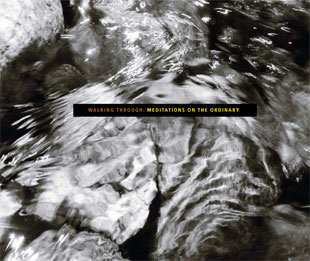
Click image for more
|
| |
|
| |
|
Tell Me What You Really Mean to Say
By Judy Anderson
Denver, Colorado: Judy Anderson, 2001. Edition of 7.
4.5” x 4” x 1” closed, extends to 225"; 60 pages. Printed text and images via digital printing. Hand bound. Drawings and images as well as text by the artist. Accordion extending from front pastedown. Signed and numbered by the artist.
Judy Anderson: "I have always been fascinated with the complexities of conversations between a woman and a man. That what someone says with words might not be what they really mean to say. In this book, the viewer can "read" the text through symbols or letterforms, constructing their own interpretation of what is really being said."
$375 |
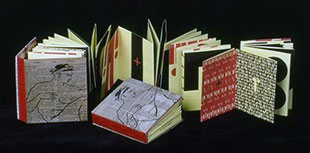
Click image to enlarge |
| |
|
| |
|
Fragments from the Stacked Deck
By Judy Anderson
Atlanta, GA: Nexus Press, 1995.
30 cards, 1 folded single sheet. Mohawk paper.
Judy Anderson: "This book was created during an artist residency at Nexus Press where I worked with a press-man on a Heidelberg Press. 500 large sheets of Mohawk paper were overprinted with 15 offset litho plates images and trimmed to twenty-nine cards that fit into a paper box. The overprinted images depict the contradictory treatment of women in our contemporary world. Text from the daily news is collaged with text from advertising. The abstract and symbolic images of women respond to the objectification of woman as a beautiful object, to love, own, violate and control. “
Colophon: "This book began in outrage, a response to the increasing reports of violence against women in the world. It's ending marks a beginning, of understanding and balance. Text fragments were taken from the daily news, juxtaposed with one woman's voice.”
$175 (Last Copy) |
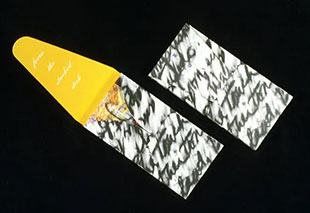
Click image for more |
| |
|
|
|
|
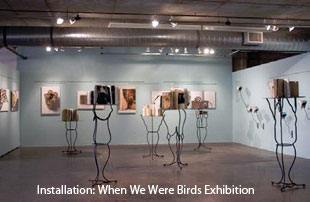 Artist statement: "When We Were Birds pours poems into, around, and through a grouping of sculptural book forms. The volumes, mounted on tall steel platforms, stand like monuments – a paper city on a hill. This is book as icon, book as reliquary for the stories and songs that comprise our lives. Nearby, collaged paintings and one-of-a-kind photographic prints take you deep into the spirit and substance of the book forms, as if a 4-inch tourist were strolling through the pages. Luminous images celebrate details of the work – surfaces painted, drawn, inked, printed and overprinted. Poems rise from and melt back into the images." Artist statement: "When We Were Birds pours poems into, around, and through a grouping of sculptural book forms. The volumes, mounted on tall steel platforms, stand like monuments – a paper city on a hill. This is book as icon, book as reliquary for the stories and songs that comprise our lives. Nearby, collaged paintings and one-of-a-kind photographic prints take you deep into the spirit and substance of the book forms, as if a 4-inch tourist were strolling through the pages. Luminous images celebrate details of the work – surfaces painted, drawn, inked, printed and overprinted. Poems rise from and melt back into the images."
Judy Anderson: "The sculpted books are comprised of fragments of my work, culled from the last 25 years, and rebuilt as sculptural codex volumes that bind together pieces of experience to capture the process of learning and becoming that has made me who I am. There is something freeing about tearing up things you have carefully preserved and making something altogether new from the pieces. The prints and paintings, and the bird books are wholly new, too, alive with light, and in many cases, vibrant color after years of a more somber palette."
Ginny Hoyle: "When We Were Birds traces an arc of human experience from birth to maturity – Judy and I both turn 64 this year. And on that frame I have placed poems and prose to add texture, music, and narrative relevant to our experience now – living, learning, and creating on the other side of 60: 'a time to rise on homemade wings and praise this juicy day. So much to forgive. So much to regret. So much to lose. So much to love before the light fades." |
| |
|
When We Were Birds
By Judy Anderson, artist, & Ginny Hoyle, poet
Denver, Colorado: Judy Anderson, 2011. Second edition of 10.
4 x 6 x 2.5"; 160 pages plus endsheets. Archival full color printing on 190 gsm watercolor paper. Set in Jensen and Frutiger type. Photographic images. Sewn and cased into wood covers. Signed by both artists. Numbered.
Image pages feature photographed details from a group of artists' books created by Judy Anderson and featuring poems by Ginny Hoyle. The first edition volumes were bound as wall-mounted sculptures. This second edition is perfect bound with wood covers.
Colophon: "We are two women, two friends, moving into our 60s on a tide of energy that feels both fierce and benevolent. We are kindred spirits who share a certain world view and speak of it in distinctly different voices, each one shining a light on the other. There is, for both of us, a sense of heightened clarity, a sharper focus that seems to be feeding our work now. When We Were Birds expresses that energy. We have been collaborating on artist book projects and installations since 1987. When We Were Birds is a shared reflection on the last 25 years, an expression of lamentation and praise for the human condition, as seen through the filter of our eyes and experience."
$800 |
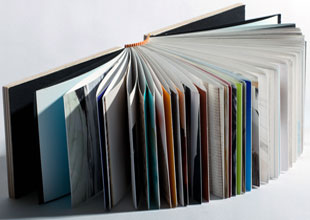
Click image for more
|
| |
|
|
| X Press Publications, Judy Anderson: “I got a taste of letterpress printing in 1981 when I collaborated with Bill Jackson of 4 Ducks Press in Wichita to publish Indulgences. Inspired, I bought a 10” x 15” platen press where I promptly smashed off the end of one finger! In spite of that, I continued producing editioned letterpress books (under the moniker X Press) until 1989 when I sold the press to a graduate student. With new digital technology, This allowed me to experiment with more sculptural one-of-a-kind works, signaling the end of X Press.” |
| |
|
X
By Frank Graziano and Judy Anderson
[Denver, Colorado]: X Press, 1988. Edition of 50.
6.5 x 9.25"; 36 pages. Four-color letterpress on Speckletone Text with Canson and Strathmore flysheets. Die-cut covers. Signed and numbered on the colophon by Anderson. Hardcover (20 copies): casebound in black cloth. Softcover (30 copies): paper wraps of black Canson paper.
This production is the result of an image and poem dialogue between Judy Anderson and Frank Graziano.
Judy Anderson: "The letter X was selected as the starting point for the poem and image interaction that followed. A sequence was established where verbal elements respond to visual; visual to verbal, until the rhythm, patter and content conclude in a restatement of the original sequence."
Frank Graziano is a writer and John D. MacArthur Professor of Hispanic Studies at Connecticut College.
$225 Hardcover
$175 Softcover |
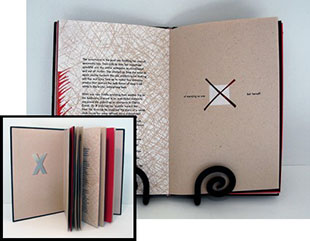 Click image for more
Click image for more |
| |
|
| |
|
The Dissolution of Freddie
By Juliet Wittman and Judy Anderson
Denver, Colorado: X Press, 1987. Edition of 50.
6.75 x 8.75"; 48 pages. Four-color letterpress and silkscreen on Strathmore Espirit, UV Ultra papers. Strathmore end sheets. Signed and numbered on the colophon by Anderson. Hardcover (25 copies): case bound with Strathmore charcoal paper. Softcover (25 copies).
This is third X Press book, a collaboration between writer Juliet Wittman and book designer Judy Anderson.
Judy Anderson: "Interpreting Wittman's short story I attempted to visually express the jarring terrifying dream sequence that invades the mundane journal notations of the woman narrator. The clear separation between the violent dream sequences and her own life becomes unclear until they visually collide at the end of the story. This becomes a strong statement about the violence that exists in the world and the ease in which we tune it out after watching the evening news."
Juliet Wittman: "In the early 1980s, I interviewed several refugees from Guatemala and El Salvador. I had read about the terrible repression in those countries, but there's something extraordinarily intense about hearing stories of murder from witnesses, and torture from those who experienced it. I was unable to sleep for weeks, but my friends' lives went on as usual: They chatted about dinner parties, books and movies, spouses and dates. Meanwhile the immigration authorities sent these refugees back to the very countries where their lives were in danger.
"'The Dissolution of Freddie' arose from the contrast between everyday, middle-class American life and the suffering of people in other countries -often at the hands of governments we support. The particulars have changed, but worldwide suffering - and our blind refusal to face or understand it -remains."
Juliet Wittman is the author of Breast Cancer Journal: A Century of Petals, the theater reviewer for Westword (a Denver weekly), and teaches in the Program for Writing and Rhetoric at the University of Colorado.
$225 Hardcover
$175 Softcover |
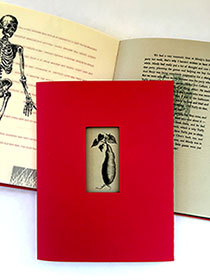
Softcover
Click image for more
|
| |
|
| |
|
Night Walking
By Judy Anderson
Denver Denver, Colorado: X-Press Editions, 1987. Edition of 20.
6.75” x 9.5”; 44 pages. Monoprint. Silkscreen. Letterpress. Offset. Printed in four colors. Text type is Vogue Linotype with Continental display type. Arches Cover White, UV Ultra Heavy and Strathmore flip sheets. Softcover with Japanese stab binding. Introductory phrases taken from “The Long View” by Elizabeth Jane Howard. Signed and numbered by the artist.
Judy Anderson: "When my twin sister Jane and I were young, we shared a terrifying recurring nightmare. This book began when Jane moved to Singapore, it was if we were tragically separated. Those feelings and remembered dream sequences inspired the book. The first, reading from front to back, dissolves as the book progresses. The second sequence reads from back to front, dissolving as they meet and overlap in the middle. Although I love this book dearly, it is hard for Jane to read it as it brings back such vivid dreams."
Colophon: “Frenzied eye movement signals the life beyond. Three or more a night, three hundred sixty five days a year, forty years, forty three thousand eight hundred plus in her memories. This second X Press book was completed in January 1987 tracing remembered dreams from childhood through last night.
$850 |
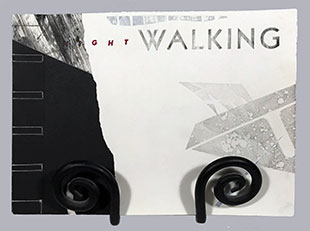
Click image for more |
| |
|
| |
|
Tokyo Press Check: Making Face
Text by Ginny Hoyle
Book Design by Judy Anderson
Denver, Colorado: X Press Books, 1986. Edition of 40.
9.25” x 7.25”; 36 pages. Type is Cairo. Japanese calligraphy by Mitzuko Santo. Printed on a 10 x 15” Chandler & Price platen press. Silk screen images. Text paper is Japanese Toyo Kurumi. Cover is Arches. Overlay are UV Ultra II. Tip sheets are Okawara Hand made. Press check masks are printed on Mohawk superfine cover. Two texts: reading from front to middle: second reading from back to middle. Japanese stab binding. Signed and numbered by Anderson.
Judy Anderson: "In 1985 I worked in Tokyo, overseeing a large book project designed for the Brooklyn Museum. My presence there, as a young American woman directing the project, was a unique experience for both me and the male printing and publishing personnel. I was fascinated by the Japanese culture, their use of language, the role of alcohol, sleep and women. And how they used their faces as masks, hiding their true feelings. Being polite. Pretend.
"One day in a small market in Tokyo, I came across some masks that were offered for sale. They were beautifully made and had an intensity of expression that was startling. I bought three and have since learned what a rich heritage they have in the theater and art and life of Japan. These masks are my interpretations of classical theatrical masks, from the shrine dances of Kagura and Bugaku dance drama to the classic Noh tragedies of feudal Japan and the animated Bunraku puppet shows that have survived to fascinate audiences of today.
"In Japanese theater, the mask controls the wearer. In the solemn ceremony of putting on the mask, the actor gives himself over to the soul of the mask, hoping that he may project the vital essence of the mask itself. Small wonder that wearing a mask in Japan, in the theater or in daily life, is an act of honor and respect. "
$650 |
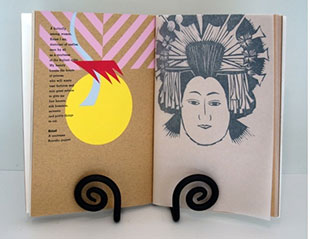
Click image for more |
| |
|
|
| Anderson & Hoyle Out of Print Title: |
|
| |
|
Fragments from the Stacked Deck
By Judy Anderson
[Atlanta, Georgia]: X Press, 1993. One-of-a-kind.
Boxed set of 29 double-sided loose-leaf cards mounted on museum board. Images created using monotypes, drawings, and collage. Plexiglass box 4.25 x 8 x 3" with clear sliding lid. Short title – [fragments] etched in lid. Includes copy of the 1995 Nexus Press edition. Signed by the artist.
Colophon: "This book originated during the winter months of nineteen ninety-two in response to increasing reports of rape and violence against women in the world. Text fragments were taken from the daily newspaper, magazines, and advertising. Images were created using drawings, monotypes, and collage, then reproduced in Xerox form."
Judy Anderson: "The deck of cards is random. That is part of the concept...being dealt a hand of cards randomly and making a life from the cards you get."
(SOLD) |
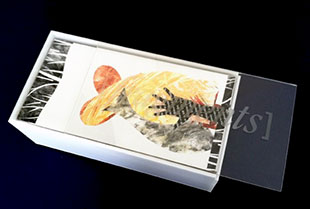
Click image for more |
| |
|
House of Rivers, House of Clay
By Judy Anderson & Ginny Hoyle
Denver, Colorado: Judy Anderson, 2007. Edition of 6.
9.75 X 12.75 x 1"; 178 pages. Images were printed by a high resolution archival digital press on Kozo-Shi paper by Infinite Editions. Text printed on a digital Epson Photo 2000. Domtar Solutions text sheets, Canson Mi-Teintes endsheets. Casebound, cloth with foil-stamp titles, handsewn onto tapes.
This fine press edition of 37 poems was part of an installation by artist Judy Anderson and poet Ginny Hoyle at the Museum of Outdoor Art, Englewood, Colorado. Each poem is allowed its own quiet space. The four sections (roughly thematic groups: earth, air, fire, water) are separated by a page of images from the installation.
Judy Anderson: "This is the only full publication of all the poems that comprised the installation House of Rivers, House of Clay (Museum of Outdoor Art, Englewood, Colorado ). Individual poems have been published in other poetry journals....The installation takes liberties with each poem where the form of the word, the material, shape, sequence express the content in a very subjective way. Since the poems in the exhibition were not readable in a linear format, we decided to create a quiet typographic book where the form of each poem was neutral, allowing the reader to visualize the ideas each represents. The installation was pushing the idea of book; the manuscript celebrates the traditional book form."
Anderson and Hoyle have collaborated for over 20 years.
Ginny Hoyle, member of Denver's Lighthouse Writers Workshop, is an award-winning writer/poet with roots in journalism and copywriting. Two poems in this collection, "House of Clay" and "I Was Sixteen," have been selected for publication in the 2007 edition of MARGIE, a national poetry journal and past winner of the Book Critics Circle Award in March.
Judy Anderson, artist and teacher, has taught at universities in Washington, Colorado and California. She is the director of PlatteForum, an artist residency program and innovative art education facility in Denver that connects working artists with underserved youth. Her artist books are exhibited in galleries and museums in the United States, Japan, the United Kingdom, Europe and the former Soviet Union, and are part of major national collections in the United States and Germany.
(SOLD) |
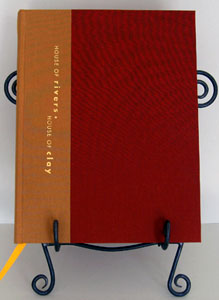
Click image for more
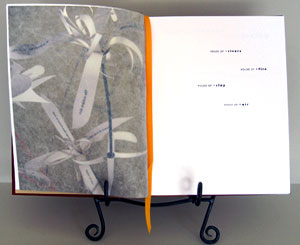
Click image for more
|
| |
|
| |
|
Page last update: 10.31.2024
|
